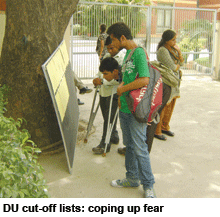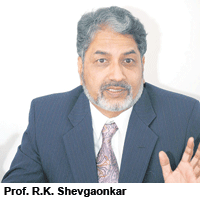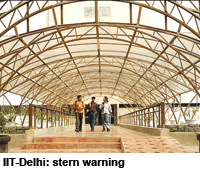Delhi: Quota complexities
With the release of Delhi University’s first cut-offs list for admission into its 65 affiliated colleges offering 54,000 undergraduate seats on June 25, the stage is set for implementing the new rules for admission of OBC (other backward castes/classes) students who have a 27 percent reserved quota in all Central government-funded higher education institutions.
 The new rules — framed by a two-judge bench of the Supreme Court comprising Justice R.V. Raveendran and Justice A.K. Patnaik by its order of August 18, 2011 (P.V. Indiresan vs. Union of India) — stipulate that the cut-offs for OBC candidates can be 10 percent below the minimum eligibility criterion instead of 10 percent below the last cut-offs of general merit candidates. For example, admission into DU’s B.Com degree programme requires a minimum score of 45 percent (as in most other courses) in the best of four subjects (three subjects and one language). This year, the 10 percent relaxation will be given to OBC candidates on the minimum eligibility threshold of 45 percent unrelated to the cut-offs for merit quota applicants, which is 90-97 percent in most colleges.
The new rules — framed by a two-judge bench of the Supreme Court comprising Justice R.V. Raveendran and Justice A.K. Patnaik by its order of August 18, 2011 (P.V. Indiresan vs. Union of India) — stipulate that the cut-offs for OBC candidates can be 10 percent below the minimum eligibility criterion instead of 10 percent below the last cut-offs of general merit candidates. For example, admission into DU’s B.Com degree programme requires a minimum score of 45 percent (as in most other courses) in the best of four subjects (three subjects and one language). This year, the 10 percent relaxation will be given to OBC candidates on the minimum eligibility threshold of 45 percent unrelated to the cut-offs for merit quota applicants, which is 90-97 percent in most colleges.
This means all DU-affiliated colleges barring six minority institutions (which are exempted from reserving 27 percent seats for OBC candidates) are free to stipulate rock-bottom 40.5 percent (subtract 4.5 from 45) for OBC, scheduled caste and scheduled tribe students against 80-84 percent cut-offs stipulated even by off-campus evening colleges such as Shyama Prasad Mukerji College for Women and Shyam Lal College. The expectation within DU is that under the new rules, all OBC quota seats (14,580) will be filled, avoiding the ‘wastage’ of last year when vacant seats in the reserved quota had to be transferred to general merit list candidates when all efforts to fill reserved positions failed.
Prof. I.S. Bakshi, principal of Dyal Singh College (estb. 1959) in which OBC quota seats remained vacant last year, is hopeful of filling them this year. “Under the new rules framed by the Supreme Court, it will be easier to fill up all quota seats because the 10 percent differential rule has been replaced by the 10 percent below minimum eligibility criterion which is much more generous,” says Bakshi.
In this connection, it’s pertinent to bear in mind that these rock-bottom cut-offs are also applicable to SC and ST Plus Two school-leavers, with the exception that OBC category seats if unfilled can be transferred to the general merit quota. However, under Delhi University rules, SC and ST seats are not transferable and if unfilled, go abegging. Admission into the 8,100 SC and ST undergraduate seats is fully supervised by DU’s special cell with affiliated colleges playing no role.
With the liberal new admission rules for reserved categories likely to fill up most classrooms, DU academics express fears about the cognitive and cultural divide within them. Hansraj College principal Prof. V.K. Kwatra fears that quota students entering top-ranked colleges won’t be able to keep up with merit students averaging 92-97 percent. “In a few programmes such as BA (economics) and B.Com (honours), students from reserved categories will find it difficult to cope because these study programmes are very demanding and competitive. Of course, we are planning to start remedial classes for reserved quota students but it will be a hard grind for them,” warns Kwatra.
What he leaves unsaid for reasons of political correctness is the widespread fear in DU and its affiliated colleges that with 49.5 percent of classes filled with reserved quota students, already low (by global norms) teaching-learning standards could plunge further.
Vimal Chander Joshi (Delhi)
Deadly prescription
Surprisingly, 800 of the 4,805 OBC (other backward castes/classes) students who cleared the Indian Institutes of Technology-Joint Entrance Examination (IIT-JEE) held on April 8, have mysteriously stopped short of pressing their claim under the 27 percent quota reserved for OBC students in the country’s 16 IITs. For the first time ever, 200 of them have requested to be assessed for admission under the general merit category, and 600 failed to report for counseling for which the last date of registration was June 10.
 Academics in IIT-Delhi — the organisers of this year’s JEE — attribute these revised applications and no-shows to the stern statement issued by JAB (joint admissions board) of the IITs warning students who had falsely registered as SC (scheduled castes), ST (scheduled tribes) and OBC candidates on the basis of fake caste certificates, that they will be barred from writing the IIT-JEE for life. “A warning was issued following some complaints from individuals who called in to say that many candidates claiming to be under the OBC category had made false declarations. JAB cross-checked with the OBC Commission’s website and found it was true. Hence, we issued the warning,” says Prof. R.K. Shevgaonkar, director of IIT-D.
Academics in IIT-Delhi — the organisers of this year’s JEE — attribute these revised applications and no-shows to the stern statement issued by JAB (joint admissions board) of the IITs warning students who had falsely registered as SC (scheduled castes), ST (scheduled tribes) and OBC candidates on the basis of fake caste certificates, that they will be barred from writing the IIT-JEE for life. “A warning was issued following some complaints from individuals who called in to say that many candidates claiming to be under the OBC category had made false declarations. JAB cross-checked with the OBC Commission’s website and found it was true. Hence, we issued the warning,” says Prof. R.K. Shevgaonkar, director of IIT-D.
This however, is not the only instance of unintended outcomes of the continuous expansion of reserved quotas in institutions of higher education. Last year, an admissions scam rocked Delhi University (DU) when 12 students secured admission into top-ranked colleges including the Sri Ram College of Commerce, Kirori Mal College, Kamala Nehru College, Delhi College of Arts and Commerce under reserved quotas on the basis of fake caste certificates. A gang of three (two of them working in offices of tehsildars — district revenue collectors authorised to certify SC, ST and OBC students) issued certificates to non-reserved category students for a consideration of Rs.3-5 lakh and managed to include their names on the official website of the National Commission of Backward Classes as having been admitted under the OBC quota.
Academics in the national capital cite these scandals as unforeseen but inevitable outcomes of interference by populist politicians in academic affairs. In 2005, the then Union human resource development (HRD) minister in the Congress-led UPA-I coalition government in New Delhi, Arjun Singh sprang a surprise on his cabinet colleagues by proposing an additional reserved quota (i.e. in addition to the 22.5 percent quota reserved for SCs and STs) for OBCs in all Central government-funded institutions of higher education invoking the long-forgotten Mandal Commission Report (1980) which claimed that OBCs constitute 53 percent of the national population. The reservation demand was limited to 27 percent to conform with the Supreme Court’s judgement in Indira Sawhney vs. Union of India (1993) which imposed a 50 percent ceiling on reservations in education institutions and government employment.
 With leaders of all political parties afraid to alienate the massive OBC vote bank, the Constitution (Ninety-Third Amendment) Act, 2005 was speedily enacted by Parliament to insert Article 15 (5) into the Constitution empowering the State (i.e. Central and state governments) to reserve quotas for SCs, STs and OBCs in all higher education institutions notwithstanding any court judgements. This has emboldened the Central and state governments to impose reserved quotas on government and private colleges countrywide with some governments (Tamil Nadu and Karnataka) merrily breaching the 50 percent ceiling imposed by the Supreme Court.
With leaders of all political parties afraid to alienate the massive OBC vote bank, the Constitution (Ninety-Third Amendment) Act, 2005 was speedily enacted by Parliament to insert Article 15 (5) into the Constitution empowering the State (i.e. Central and state governments) to reserve quotas for SCs, STs and OBCs in all higher education institutions notwithstanding any court judgements. This has emboldened the Central and state governments to impose reserved quotas on government and private colleges countrywide with some governments (Tamil Nadu and Karnataka) merrily breaching the 50 percent ceiling imposed by the Supreme Court.
Quite obviously, reservation of quotas in a handful of excellent institutions rather than upgrading the huge majority of India’s 611 universities and 31,000 colleges or permitting increase in the supply of excellent colleges and institutes by encouraging foreign universities and colleges or domestic edupreneurs to establish campuses in India, has become a quick- fix solution. “We need strong government and political will to improve the quality of higher education as a whole, and more investment to create good quality schools and colleges, as well as vocational institutes to ensure equal opportunity for all,” says Prof. Kamal Mitra Chenoy, researcher and professor, School of International Studies at the Jawaharlal Nehru University, Delhi.
But for mysterious reasons, with neither the Union nor state governments interested in addressing the supply side of Indian education and resorting to decreeing reserved quotas in the small minority of high quality education institutions, a whole new caste certification industry has mushroomed, injecting the virus of corruption into excellent education institutions. It’s a deadly prescription for dumbing them down.
Swati Roy (Delhi)














Add comment